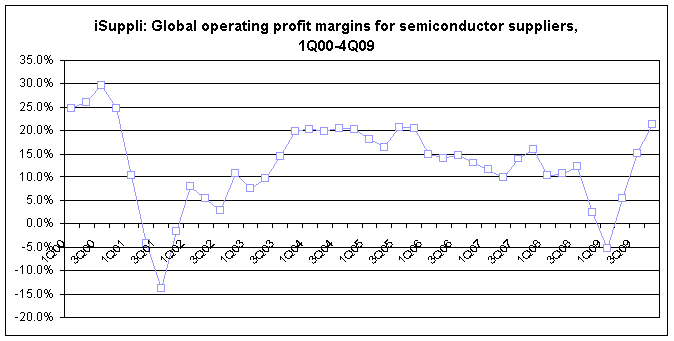大陆半导体设备 销量倍增
发布时间:2010-3-17 10:09
发布者:步从容
|
|
|
钰创(5351)董事长卢超群昨(16)日表示,目前订单能见度可达3个月,首季利基型记忆体价格已有小幅调涨,第2季若标准型记忆体价格续涨,利基型记忆体价格也有机会上调。他并透露,钰创已跨足逻辑IC领域,创造更多经验导向产品。 全球半导体联盟(GSA)昨日举办论坛,身兼GSA董事会主席的卢超群,针对整体半导体景气指出,到上半年都很乐观,但5、6月逻辑IC订单情况,将是下半年产业景气观察指标。 卢超群说,以往半导体产业以产品为导向,但近年受到社群网站、iPhone、电子书等等应用,半导体领域已与人的使用习惯经验连结,影响程度更大,未来产业市况趋稳后,将会创造更多附加价值。 展望今年半导体景气,卢超群认为,到第2季整体产业景气都很乐观,目前预期记忆体价格至少可维持平稳到明年,但逻辑产品方面是否过度乐观值得观察。 针对记忆体市况,卢超群预期,未来仍「大有可为」,未来记忆体与逻辑IC将朝堆叠一起方向走,以创造更多具经验价值产品。 他强调,半导体产业,将人类情感与喜怒哀乐连结,虽过去记忆体发展遭遇波折,但产品应用愈来愈多元,短期投资资金庞大,但长期对社会有帮助。卢超群进一步指出,人类使用经验扩大后,现阶段产业算是第二世代开始,将会产生很多价值。 他透露,钰创除利基型记忆体IC,也跨足逻辑IC领域,且目前应用在中国网路摄影机产品已抢下5成以上市占率,另也投入高速传输相关产品。 |
|
Overall semiconductor supplier operating profitability rose to 21.4% in the fourth quarter of 2009, the highest level since fourth-quarter 2000 when it reached 24.7%, according to iSuppli. Industry profitability soared in 2009, rising throughout the year after falling to negative 5.3% in the first quarter due to the impact of the global economic downturn. "Chipmakers in 2009 reacted quickly and aggressively to meet the downturn by cutting costs and improving cash flow," said Derek Lidow, president and chief executive officer of iSuppli. "And as the market began to turn back up, the industry showed great restraint against adding production in order to avoid any overcapacity situations. This allowed the companies to recapture their pricing power to boost profitability." Beyond capacity management, the profitability rebound reflects a more fundamental shift in the competitive structure of the global semiconductor industry, iSuppli said. "The semiconductor industry has almost completely eschewed the broad-line model that once was the hallmark of the largest players in the business," Lidow said. "Instead, chipmakers now are concentrating on specific market segments, allowing them to focus on areas where they have pricing power and a competitive advantage. This has allowed them to improve profit margins and to cut overhead." Large chipmakers once attempted to compete in as many semiconductor segments as possible in order to garner maximum market share. While this approach achieved growth and revenue expansion during the era of rapid growth for the semiconductor industry, it has proven to be a losing strategy as the chip business has entered a stage of greater maturity. "Broad-line suppliers constantly must fend off hordes of smaller competitors nipping at their heels," Lidow noted. "With a more narrow focus, semiconductor suppliers can gain greater efficiency and profitability. This allows them to become more competitive and to concentrate on profitability, rather than on market share." Examples of companies taking such a strategy include Infineon Technologies, which has divested its operations in the memory and communications markets among other areas, allowing it to focus on its core business in offering semiconductors and system-level integrated circuits for automotive, industrial electronics, wireless and security applications. This shift away from the broad-line model and toward a narrower focus has boosted profitability throughout the semiconductor industry, iSuppli believes. This trend will continue in the coming years, as Japanese semiconductor supplier divest themselves from various product segments and embrace more narrowly focused product lines.  Source: iSuppli, compiled by Digitimes, March 2010 |
网友评论